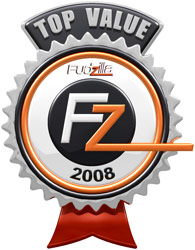Back in March, we had a chance to check out the first engineering sample of the AMD 780G chipset and you can read about it here. We were very pleased with this integrated chipset so we decided to check out some additional boards.
Due to the fact that not all boards are capable to handle a Phenom X4 9850, we decided to run all the tests with our old Phenom 9600 Black Edition. We did not overclock the CPU, but we did overclock the graphics-core if possible. Of course, we tested all boards with the same configuration. We also tested with the latest energy-efficient Athlon X2 series, and we used a 4850e. For comparability reasons we stuck to 800MHz DDR2 speeds.
Testbed:
Motherboards:
as described
CPU:
AMD Phenom 9600 Black Edition (provided by Mindfactory)
AMD Athlon X2 4850e (provided by AMD)
CPU-Cooler:
Scythe Andy Samurai Master (provided by Scythe-Europe)
Memory:
Kingston 2GB Kit PC2-9600U KHX9600D2K2/2G (provided by Kingston)
CL5-5-5-15 CR2T @400MHz 1.85V
Graphics Card:
onboard
Power supply:
Seasonic S12-II 330W
Hard disk:
Samsung SP1614C
DVD-Drive:
Samsung SH-S203D
Gigabyte GA-MA78G-S2H:
Gigabyte was the first top-tier vendor releasing a 780G board. The layout is a typical µATX board, providing one PCIe x16 port and two PCI ports. If you are not satisfied with the graphics power you can always add a more powerfull graphics card.
The VRM is a four-phase analog design, which could handle a Phenom X4 9750, but not Phenom X4 9850. This is quite strange, because the list shows 125W TDP for the 9750. We know there are two flavors of this CPU, one with 95W TDP and one with 125W TDP. Our guess is that there is a critical error in the support list and you should avoid any CPU with 125W TDP.
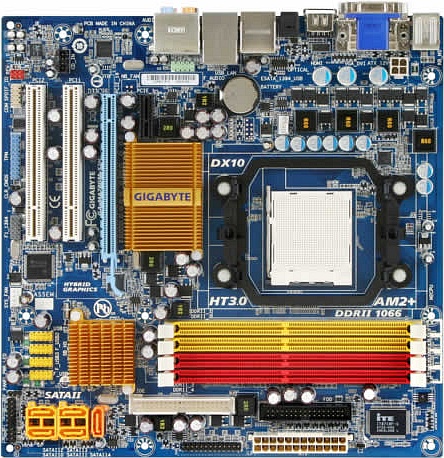
Gigabyte is using the full µATX size, so you can mount the board in your case properly. Quite annoying are the audio-connectors behind the Northbridge. The cooler gets quite hot, so there is a chance it will melt down your audio cables if you dare to put it over the Northbridge cooler. Four USB 2.0 headers gives you additional eight ports, but Gigabyte doesn't provide any USB brackets.
Network connectivity is provided by a Realtek RTL8111C PCIe chipset, audio is a custom-made Realtek ALC889A, which is actually an ALC885 with 7.1 output. Of course, the 780G includes an additional 5.1 audio codec for HD content. This board also provides Firewire 400, which may come in handy.

On the rear side you will find all connectors you may have use for. Please note that you can use either DVI or HDMI with all 780G boards. This board provides only four USB 2.0 ports, but gives you an eSATA II port. The fifth and sixth SATA port (eSATA) will only work when AHCI is enabled, otherwise you are stuck with four IDE compatible SATA ports. One Firewire port, 7.1 analog audio and an optical audio-out completes the back-panel.
The board is available in Europe for around €62,-.
ASUS M3A-H/HDMI:
This is the only full ATX board in our roundup. Due to some bugs on the Website, there are no specifications available and there is no CPU compatibility list. The VRM is a analog four+one phase design, so we speculate it can handle a Phenom X4 9850. ASUS provides a 140W compatibility list, where this board is not listed, so a Phenom X4 9950 is out of the question. For some reason, the CPU power connector is in the middle of the board, so you have to put the CPU P4 power cable around the CPU-cooler, which is a bad idea in our opinion. Even Asus used an ATX design, the Northbridge cooler is located too close to the CPU-socket, so you can run into issues when you try to install a bigger cooler such as the Scythe Andy Samurai.
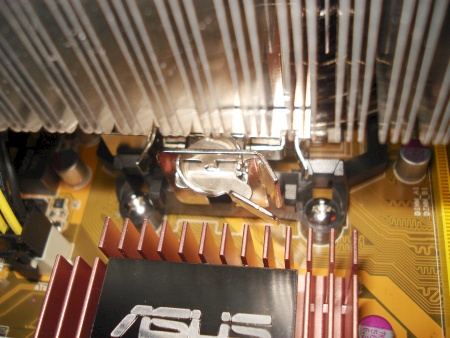
The design is pretty simple but at least it's an all solid design. One PCIe x16 port, twice PCIe x1 and three PCI ports give you plenty of options to upgrade your board. All six SATA ports are available, ASUS didn't include an eSATA port. Four USB 2.0 headers gives you additional USB 2.0 ports which are quite limited on the back-plane.
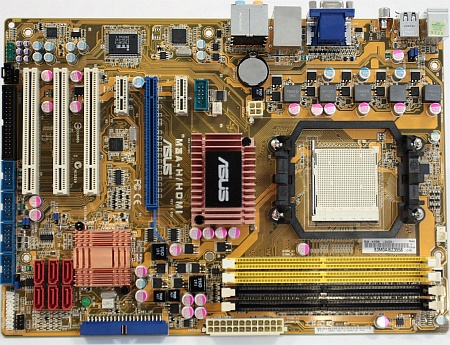
Gigabit LAN is provided by an Atheros chip, which is quite uncommon on motherboards today. We did not have any problems using it, but our tests didn't take up that much time. Realtek provides an ALC1200 for 7.1 audio; we have no clue if this a new product or just a renaming of an common chip such as Gigabyte does.
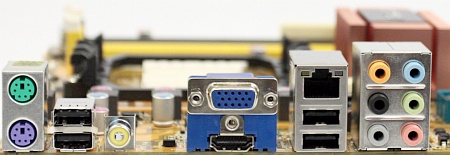
The back-plane is quite empty. You have one HDMI and one VGA connector and if you want DVI you need to use the HDMI-DVI adapter provided in the package. There are only four USB 2.0 ports are a disappointment for an ATX-board. On AMD boards ASUS still provided the PS/2 mouse-port, which has been removed on the later Intel-based boards. We would have opted for the same here, because it would have be enough for two additional USB 2.0 ports. One LAN, 7.1 audio and one coaxial digital audio-output completes the back-panel.
This boards cost about €63,-.
MSI K9A2GM-FIH:
This board hasn't really met our expectations, mainly because it comes without any solid capacitors. A complete non-solid design does save a few bucks, but on the other hand it increases the power consumption. MSI has reacted and they offer the same board with the suffix -S as full solid capacitor design, but we were not able to find it in Europe while writing this article.
Disappointed with the standard caps, the board does at least support 125W TDP CPUs but not the 140W ones. The board is full µATX providing all mounting holes for proper installation. The VRM is an analog three+one phases design, quite unusual for 125W TDP CPUs. One PCIe x16 and two PCI are quite standard, but MSI managed to put an additional PCIe x1 slot behind the Northbridge. MSI does need to reduce the height of the Northbridge cooler, to fit larger PCIe x1 cards, but the temperature stayed at safe limits while testing.
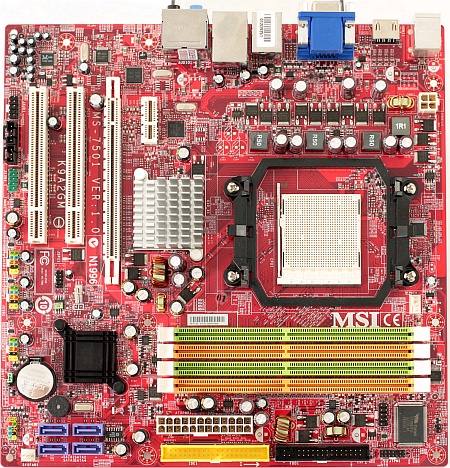
Gb LAN is provided by the usual Realtek PCIe chip RTL8111C and audio also as usual with a Realtek ALC888. This board also features a Firewire port on the backplane but not eSATA port. MSI doesn't use all six SATA II ports, so only four are available. The audio connector is next to the second PCI slot and your audio-cable does not cross the Northbridge cooler.

The back-panel is also quite standard, one VGA and one HDMI port connects your monitor, but MSI decided not to include any HDMI to DVI adapter in the box. Also, MSI leaves plenty of space on the back, so only four USB 2.0 ports are available, each dual-port with either Fireport or LAN connector on top. Sadly, MSI does only provide 7.1 analog audio connectors; no digital connector is available.
The board is available in Europe for around €56,-.
MSI K9N2GM-FIH:
This board is a cousin to the K9A2GM-FIH, but this time MSI uses Nvidia's IGP chipset. While the AMD version doesn't feature any solid capacitors, MSI heeded our suggestions and used solid capacitors for the analog four+one phase VRM design. As you will see later in the power-consumption tests, that will help the board to achieve good results. Of course, you can also only go with 125W TDP CPUs.
The same is true for the ports and features, it's quite a clone of the AMD version with one PCIe x16 slot, two PCI and one PCIe x1 slot. Also, it features the same LAN and audio chips. The Northbridge cooler is quite lame. While it's lower on the left side, for usage of larger PCIe x1 cards, it's not on the right side, which drives you nuts when installing better cooling solutions such our Scythe Andy Samurai. The cooler is too close to the CPU-socket so you can't use the clips to fix the cooler properly. We fixed this issue by removing the cooler and mouting it 180° rotated.
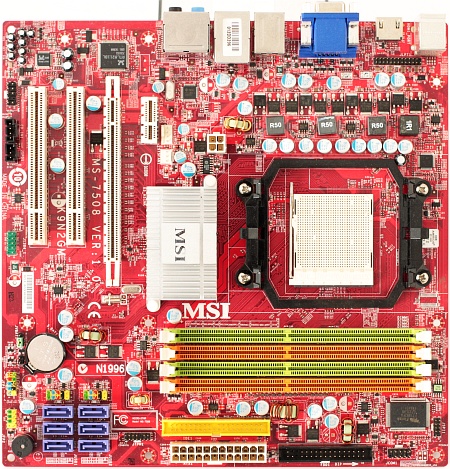
The back-panel is also a clone of the AMD-based board with one VGA and one HDMI connector, but you will not find a HDMI to DVI adapter in the package. Also, only four USB 2.0 ports are quite a disappointment. At least you will find a Firewire-port and a LAN-port over the dual-USB-ports. More disappointing is there are only 7.1 analog audio connectors, no digital out is available.
The price is around €57,- in Euroland.

J&W RS780UVD-AM2+:
We have already checked the pre-production sample in March. The final design has only slightly changed, so expect black SATA-connectors and a black heatsink without the AMD-logo on the new board.
The board does not use the full µATX size, which is quite lame because the board can't be fixed as good as it should, because it's about 1cm shorter. One PCIe x16 and two PCI slots are standard for such a board. The analog three+one phase VRM design handles only 95W TDP CPUs and therefore do not try to use more power-hungry CPUs, as it might kill the board. Besides the Port 80 onboard diagnostic the board also features unique 64MB onboard memory for the 780G chipset, which is called sideport-memory. This will help in graphics intensive applications or games.
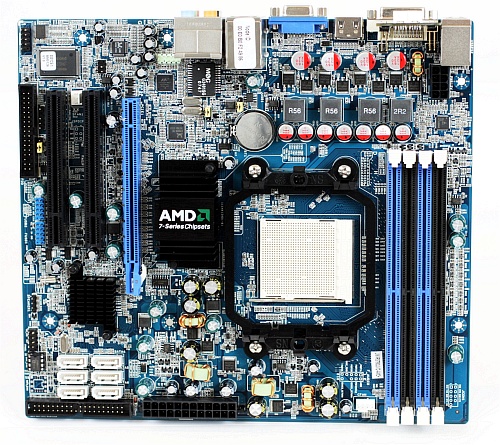
The back-panel is quite empty. While featuring VGA, DVI and HDMI, of course you can use either DVI or HDMI, you get only four USB 2.0 ports, one LAN and only 7.1 analog audio connectors. While some of the space is eaten by the LED display for the onboard diagnostic, we would have wished for an optical output on the panel. At least J&W does provide a slot bracket for that.

The board should ship for €59,- but we were not able to find any source.
Before we move to testing let's say that support for even only 95W is quite okay, as these boards are supposed to be used for lower-end systems and HTPC; most of the Phenoms will be an overkill for such a system because the 780G is capable of decoding VC1 and MPEG streams.
Benchmarks:
Please note that different BIOS revisions may give different results. All benches are done with 1.20VCore for the CPU and CL5-5-5-15CR2T settings. Northbridge voltage was increased by about 0.2V for overclocking the graphics-core.
x264:
x264 is a h.264/AVC codec which supports four threads, and it's available for free. We took a PAL episode of "Babylon 5" with a length of 41 minutes, 57 seconds and 8 frames. We tried to "emulate" the most common usage when you encode your movies:
1st: We have a perfect master, so we only de-interlace the content and resize it without any other manipulations; we marked this as "fast."
2nd: You get bad mastering on many DVDs, especially "old" stuff or when the studios are in a hurry for the release. In this case you want to improve the picture quality, which is done by filtering the content. You can choose from lots of filters for any purposes you can think of, but we only used the most common "undot," "FluxSmooth" and "MSharpen." Of course, we also de-interlaced, filters were done before any resizing took place (which is slower). We marked this as "slow."
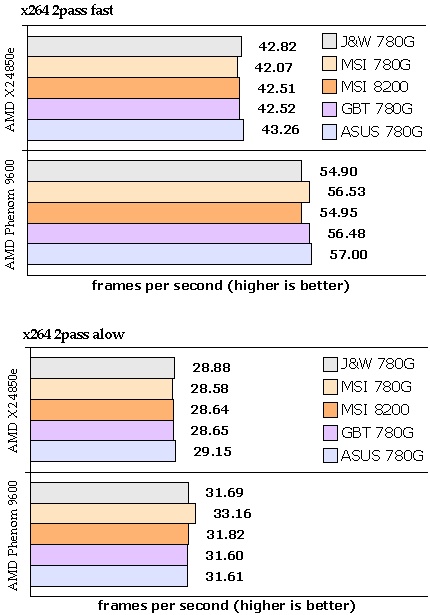
3DMark:
Some of the features of the 780G and 8200, such as Hybrid Power and Hybrid Crossfire/SLI, are exclusive to Vista which is more than lame. While testing the mainboards we didn't use "the broken" OS because it's in most cases slower compared to Windows XP. Hybrid Crossfire only helps marginally, but for a few bucks more you get a decent graphics card, which is always the better choice.
You can see that Phenom is per clock faster, as it run at 2.30GHz, while the 4850e runs at 2.50GHz. Also the sideband-memory does help, but with a bit fine-tuning ASUS comes quite close. The GeForce 8200 is a big disappointment. While we have expected it to be a bit slower, it's way behind AMD and not a choice for casual gamers at all.
J&W, MSI and ASUS overclock to 850MHz, while Gigabyte is stuck at 750MHz, so we skipped it. With 850MHz the onboard graphics surpasses a HD3450 card, especially with sideband-memory.
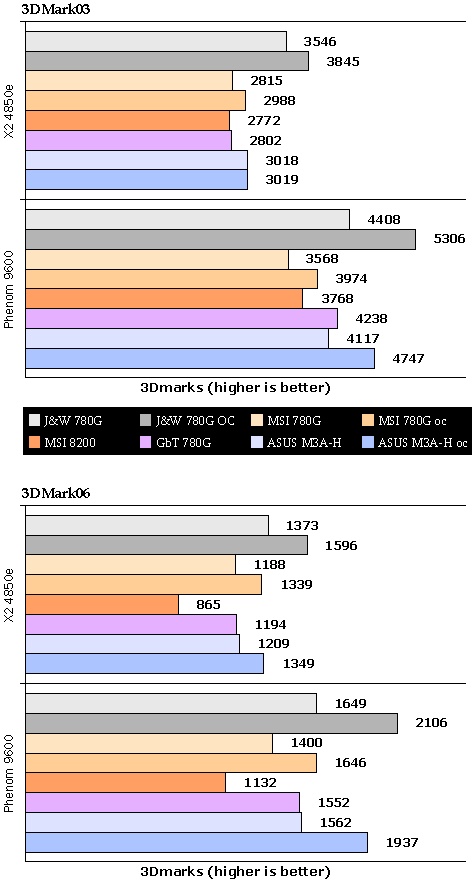
While AMD might not be the gaming platform of choice, it is a good choice for HTPC. Geforce 8200 consumes less power compared to 780G, but AMD still has the superior graphics-power and the better multimedia support. Using a 45W TDP CPU such as the AMD Athlon X2 4850e, this configuration is the best possibility to go for. J&W will introduce an ITX solution soon that we plan to review as soon as it's available.
The 4850e uses about 50W less compared to an Phenom X4 9600, the only problem which the industry needs to fix are proper power supplies. You see, even with an Phenom we reach only about 150W, but the smallest PSUs you can buy are about 330W/350W, which is quite irritating.

Conclusion:
Overall, the 780G is a great choice for quite cheap HTPC (Home Theater PC) configurations. The GeForce 8200 is no competition to the 780G, as it runs far slower. While it does save a few Watts with an Phenom CPU, the graphics power is way below compared to AMD. ASUS M3A-H/HDMI and MSI K9A2GM-FIH battled quite close for the performance win, but due the lack of solid capacitors MSI is no choice for us, considering the J&W solution is only about €3,- more expensive, but has superior features.
J&W RS780UVD-AM2+:
With its unique features such as 64MB sideband-memory and Port 80 on-board diagnostic and quite decent power-consumptions this is a clear winner. There is still some headroom to optimize the BIOS but the gap to ASUS is quite small. The board is available for about €59,- but quite hard to find in Europe.
ASUS M3A-H/HDMI:
The only ATX board in our roundup that had a decent design and even lacking sideband-memory, the design and BIOS gives you quite close scores. With CPU and memory intensive applications such our x264 bench its shows solid performance. The board is available for about €63,- which is quite cheap for an all solid capacitor ATX board and only a few bucks more compared to other µATX solutions.
We can recommend both boards.
